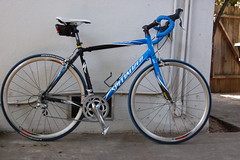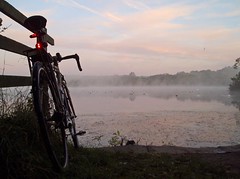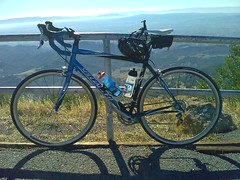Well, apparently tough gearing is not so smart and high cadence (pedal revolution rate) is a key for efficiency. This is not as easy as it sounds for me though since I'm used to feeling more resistance on the pedals. I figure since I'm practically learning to pedal all over again, I would be sure to take high cadence as a goal during my training rides.
I'm far from the expert, but my reading has suggested that somewhere between 85 and 105rpm is the sweet spot for efficient road riding, unlike our rider above. I think this varies from person to person, but the gist is that the low resistance will better tune your riding muscles during the initial periods as well as bring your body to a "peak" for riding.
Now, during my Monday and Wednesday training rides, I shift to my smaller chainring and push up the RPMs, focusing on pedaling technique. For a while, I started bouncing on the saddle, and I initially thought this was a question of saddle position. Instead, with a tip from another local rider, he suggested I focus on completely lifting my weight off of the pedal on the upstroke. What a difference! Instead of thinking about pulling up the pedal, simply focusing on removing the weight from the pedal makes for a big change.
I now have a cadence monitor, but I tried to count revolutions per second to give me an idea of RPM. 1 revolution per second, I was doing 60 RPM. 2 revolutions per second would be 120 RPM. So I would aim somewhere in between to reach that 85-105 RPM range, something like 3 revolutions per 2 seconds.
What do you think? How big of a role does cadence have in your training?







